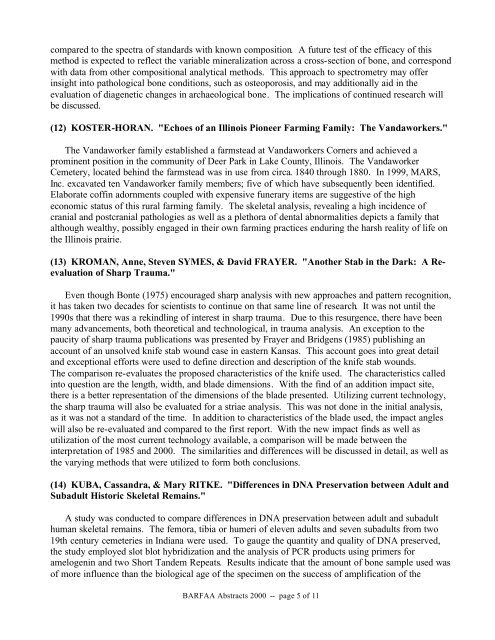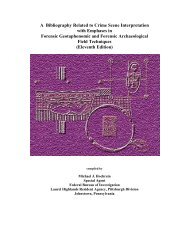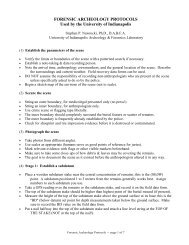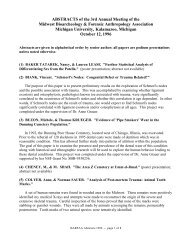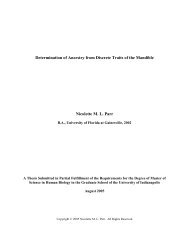Abstracts - University of Indianapolis Archeology & Forensics ...
Abstracts - University of Indianapolis Archeology & Forensics ...
Abstracts - University of Indianapolis Archeology & Forensics ...
You also want an ePaper? Increase the reach of your titles
YUMPU automatically turns print PDFs into web optimized ePapers that Google loves.
compared to the spectra <strong>of</strong> standards with known composition. A future test <strong>of</strong> the efficacy <strong>of</strong> this<br />
method is expected to reflect the variable mineralization across a cross-section <strong>of</strong> bone, and correspond<br />
with data from other compositional analytical methods. This approach to spectrometry may <strong>of</strong>fer<br />
insight into pathological bone conditions, such as osteoporosis, and may additionally aid in the<br />
evaluation <strong>of</strong> diagenetic changes in archaeological bone. The implications <strong>of</strong> continued research will<br />
be discussed.<br />
(12) KOSTER-HORAN. "Echoes <strong>of</strong> an Illinois Pioneer Farming Family: The Vandaworkers."<br />
The Vandaworker family established a farmstead at Vandaworkers Corners and achieved a<br />
prominent position in the community <strong>of</strong> Deer Park in Lake County, Illinois. The Vandaworker<br />
Cemetery, located behind the farmstead was in use from circa. 1840 through 1880. In 1999, MARS,<br />
Inc. excavated ten Vandaworker family members; five <strong>of</strong> which have subsequently been identified.<br />
Elaborate c<strong>of</strong>fin adornments coupled with expensive funerary items are suggestive <strong>of</strong> the high<br />
economic status <strong>of</strong> this rural farming family. The skeletal analysis, revealing a high incidence <strong>of</strong><br />
cranial and postcranial pathologies as well as a plethora <strong>of</strong> dental abnormalities depicts a family that<br />
although wealthy, possibly engaged in their own farming practices enduring the harsh reality <strong>of</strong> life on<br />
the Illinois prairie.<br />
(13) KROMAN, Anne, Steven SYMES, & David FRAYER. "Another Stab in the Dark: A Reevaluation<br />
<strong>of</strong> Sharp Trauma."<br />
Even though Bonte (1975) encouraged sharp analysis with new approaches and pattern recognition,<br />
it has taken two decades for scientists to continue on that same line <strong>of</strong> research. It was not until the<br />
1990s that there was a rekindling <strong>of</strong> interest in sharp trauma. Due to this resurgence, there have been<br />
many advancements, both theoretical and technological, in trauma analysis. An exception to the<br />
paucity <strong>of</strong> sharp trauma publications was presented by Frayer and Bridgens (1985) publishing an<br />
account <strong>of</strong> an unsolved knife stab wound case in eastern Kansas. This account goes into great detail<br />
and exceptional efforts were used to define direction and description <strong>of</strong> the knife stab wounds.<br />
The comparison re-evaluates the proposed characteristics <strong>of</strong> the knife used. The characteristics called<br />
into question are the length, width, and blade dimensions. With the find <strong>of</strong> an addition impact site,<br />
there is a better representation <strong>of</strong> the dimensions <strong>of</strong> the blade presented. Utilizing current technology,<br />
the sharp trauma will also be evaluated for a striae analysis. This was not done in the initial analysis,<br />
as it was not a standard <strong>of</strong> the time. In addition to characteristics <strong>of</strong> the blade used, the impact angles<br />
will also be re-evaluated and compared to the first report. With the new impact finds as well as<br />
utilization <strong>of</strong> the most current technology available, a comparison will be made between the<br />
interpretation <strong>of</strong> 1985 and 2000. The similarities and differences will be discussed in detail, as well as<br />
the varying methods that were utilized to form both conclusions.<br />
(14) KUBA, Cassandra, & Mary RITKE. "Differences in DNA Preservation between Adult and<br />
Subadult Historic Skeletal Remains."<br />
A study was conducted to compare differences in DNA preservation between adult and subadult<br />
human skeletal remains. The femora, tibia or humeri <strong>of</strong> eleven adults and seven subadults from two<br />
19th century cemeteries in Indiana were used. To gauge the quantity and quality <strong>of</strong> DNA preserved,<br />
the study employed slot blot hybridization and the analysis <strong>of</strong> PCR products using primers for<br />
amelogenin and two Short Tandem Repeats. Results indicate that the amount <strong>of</strong> bone sample used was<br />
<strong>of</strong> more influence than the biological age <strong>of</strong> the specimen on the success <strong>of</strong> amplification <strong>of</strong> the<br />
BARFAA <strong>Abstracts</strong> 2000 -- page 5 <strong>of</strong> 11


